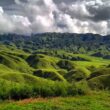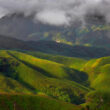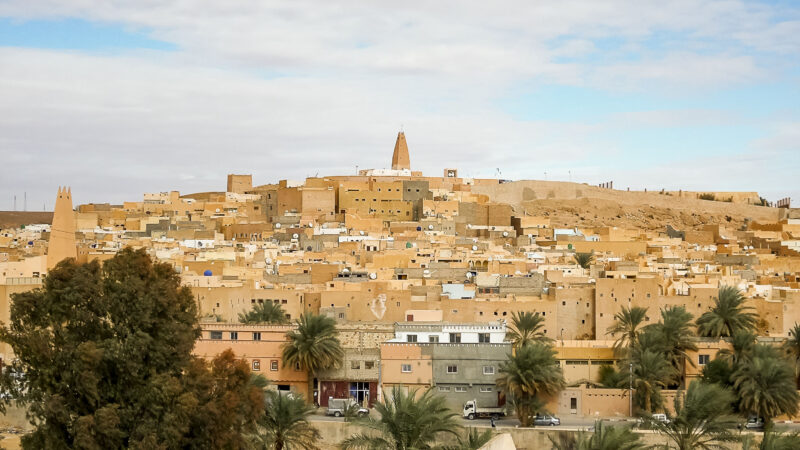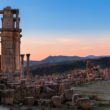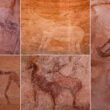Tucked away in the heart of the northern Sahara, the M’Zab Valley is one of Algeria’s most fascinating yet underappreciated gems. Recognized by UNESCO in 1982 as a World Heritage Site, M’Zab is not just a place — it’s a living testament to resilient architecture, spiritual harmony, and community-centered urban design. Located in Ghardaïa Province, the valley comprises five historic hilltop towns (called ksour), each radiating timeless charm and offering a unique glimpse into Mozabite life.
Whether you’re a cultural traveler, architecture enthusiast, or seeker of authentic experiences, M’Zab Valley is a must-visit destination in North Africa.
Where is M’Zab Valley?
M’Zab Valley is located in central Algeria, about 600 km south of Algiers, in the Ghardaïa Province. It lies on the edge of the Sahara Desert and is well connected by road and air, with Ghardaïa Airport being the nearest access point.
The valley includes five main ksour (fortified villages), collectively known as the Pentapolis:
- Ghardaïa
- Melika
- Beni Isguen
- Bounoura
- El Atteuf
The History of M’Zab Valley
Founded in the 10th century by the Ibadi Muslims, the Mozabites sought refuge in the harsh Saharan environment to practice their faith freely. Over time, they built a self-sufficient and spiritually grounded community adapted perfectly to the desert’s demands. The architecture and layout of the towns reflect religious values, equality, and environmental consciousness.
This community-based urban planning has endured for over a millennium — a true example of sustainable development before the term existed.
What Makes M’Zab Valley Unique?
1. Ibadi Islamic Culture
The valley is a stronghold of Ibadi Islam, a moderate branch distinct from Sunni and Shia traditions. This influences everything from town planning to architecture, placing community, modesty, and functionality at the core.
2. Circular Urban Design
Each ksar is built around a central mosque that doubles as a fortress. Streets spiral outward from the center, reflecting egalitarian principles — everyone, regardless of wealth, lives near the mosque.
3. Defensive Architecture
Houses are designed to protect from the desert heat and enemies. Thick walls, small windows, and shared courtyards keep the interiors cool and foster communal ties.
4. Color-Coded Identity
Each ksar uses different earth tones for its buildings — a practice that maintains aesthetic harmony and helps distinguish one town from another.
Top Things to Do in M’Zab Valley
1. Explore the Market of Ghardaïa
The bustling souk (market) in Ghardaïa is a sensory delight — offering spices, textiles, traditional crafts, and the region’s famed dates.
2. Tour Beni Isguen (with a guide)
Known as the most conservative ksar, Beni Isguen restricts unguided visitors. But with a local guide, you can explore its fortified walls, watchtowers, and silent alleys.
3. Visit El Atteuf’s Mosque of Sidi Brahim
Believed to be the oldest mosque in the valley, it showcases the earliest examples of Mozabite architecture and design philosophy.
4. Learn at the Local Museum
Ghardaïa’s regional museum offers insights into Mozabite culture, religious practices, and archaeological finds.
5. Sample Mozabite Cuisine
Try traditional dishes like couscous with lamb and raisins, tagine with olives, or desert bread baked in sand ovens.
Best Time to Visit M’Zab Valley
The ideal time to visit M’Zab Valley is during the cooler months from October to March. Summers are intensely hot, often exceeding 45°C (113°F), making sightseeing difficult.
Sustainability and Preservation
The Mozabites have preserved their architecture, language (Tumzabt), and customs with remarkable integrity. Their approach to urban planning, water conservation, and community living has been studied by architects and sociologists worldwide as a model of sustainable desert living.
How to Reach M’Zab Valley
- By Air: Fly to Ghardaïa Airport from Algiers or other major Algerian cities.
- By Road: Buses and taxis connect Ghardaïa with Algiers, Laghouat, and Ouargla.
- By Tour Operator: Several Algerian travel companies offer cultural tours that include guided visits and homestays.
Travel Tips for Visiting M’Zab Valley
- Dress conservatively – this is a deeply religious area.
- Hire local guides – especially for Beni Isguen, where access is restricted.
- Avoid Fridays – many shops and sites are closed for the weekly prayers.
- Learn a few phrases in Arabic or French to connect with locals.
- Stay hydrated and carry sunscreen — it’s still the Sahara.
10 Frequently Asked Questions (FAQs) About M’Zab Valley
1. What is M’Zab Valley known for?
It’s known for its unique desert architecture, Ibadi Islamic culture, and harmonious urban planning that blends sustainability with spirituality.
2. Is M’Zab Valley safe for tourists?
Yes, it’s considered one of the safer regions in Algeria for tourists, especially in towns like Ghardaïa and Beni Isguen.
3. Can foreigners visit all five ksour?
Yes, but access to Beni Isguen requires a licensed guide, as it’s more conservative and protected.
4. Is photography allowed in M’Zab Valley?
Photography is allowed in most areas, but always ask for permission, especially when photographing people or religious sites.
5. Are there accommodations in the valley?
Yes, there are hotels and guesthouses in Ghardaïa, ranging from budget to mid-range, with some offering traditional experiences.
6. What language is spoken in M’Zab Valley?
People speak Arabic, French, and Tumzabt (the Mozabite Berber language).
7. Is the valley recognized by UNESCO?
Yes, M’Zab Valley was inscribed as a UNESCO World Heritage Site in 1982 for its cultural and architectural significance.
8. How long should I stay in M’Zab Valley?
A 2–3 day stay is ideal to explore the main towns, markets, and cultural sites.
9. Is there internet and mobile coverage?
Yes, most towns in the valley have decent mobile and internet connectivity.
10. Can I buy local crafts or souvenirs?
Absolutely — look for handwoven carpets, pottery, dates, and silver jewelry unique to Mozabite artisans.
Read about all the World Heritage Sites
Conclusion: Why You Should Visit M’Zab Valley
M’Zab Valley isn’t just another destination — it’s a journey into the soul of sustainable living, community resilience, and sacred design. In an age where cities sprawl uncontrollably, M’Zab teaches us how tradition, simplicity, and spiritual purpose can create timeless beauty.
Whether you’re drawn by its cultural depth, desert landscapes, or architectural marvels, M’Zab will leave you transformed. Add it to your Algeria itinerary — and discover one of North Africa’s most authentic and inspiring regions.

